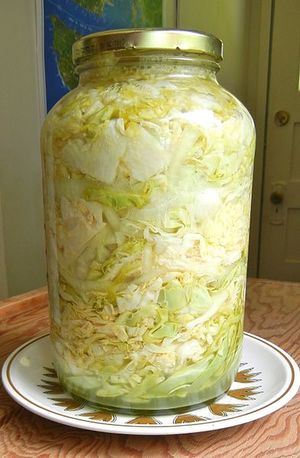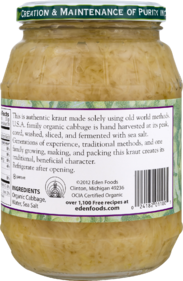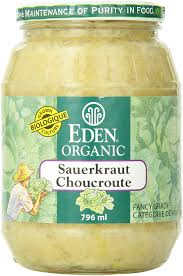Course:FNH200/Projects/2020/The fermentation process
The Fermentation Process - Sauerkraut & Kimchi
History of Fermented Foods

Fermented foods have been in production for millennia. Wine making is believed to date back to roughly 6000 BCE, and cheese making dates back to 7000 BCE in the near east. Yogurt type foods such as the Indian Dahi dates back to roughly 6000-4000 BCE, and it is believed that the Egyptians were the first to produce leavened breads using yeast in about 4000 BCE[1].
Sauerkraut, a fermented form of cabbage dates back to the roman empire, in which it served as a nutrient rich preserved food to consume during the winter months. Sauerkraut is most well known as an Eastern or Central European food but is consumed worldwide, and is growing more popular in recent years [2].
Even though fermentation practices have been in place for a very long time, it was not until much later that scientists recognized the process by which fermentation occurs. Only after Antoine van Leeuwenhoek first observed bacteria in the 1600’s CE did research on fermentation begin to accelerate. Even French scientist Louis Pasteur studied fermentation in the 1800’s and coined it as ‘la vie sans l’air’ (life without air). His research, while profound, was only the start of a long scientific discussion on fermented foods[3].
Fermentation was a fairly simple process which small communities engaged in for millennia. In the early days, some foods fermented naturally, and others were fermented with the help of yeast. At the time of the industrial revolution, fermentation was transformed from small community practice to large scale commercial production of products like wine and beer, and fermented meat and vegetables [1].
Almost every culture’s cuisine includes their own form of fermented food, whether it be alcoholic beverages, meats, leavened breads, cheese, and more. In Canada, Indigenous people have been fermenting food for generations; for example the production of igunaq, fermented walrus (or sea mammal) meat[4].
The Fermentation Process: Kimchi and Sauerkraut

Fermentation Process Overall
Fermentation is an anaerobic process for breaking down glucose, with an extraction pathway of glycolysis [5]. Moreover, in fermentation the pyruvate does not continue through oxidation and the citric acid cycle, and the electron transport chain does not run [5]. The NADH (glycolysis) cannot drop its electrons off to turn back into NAD+, introducing fermentation as a mechanism to regenerate the electron carrier NAD+ from the NADH produced in glycolysis [5].
Lactic Acid Fermentation
Lactic acid fermentation is a method used by animals and some bacteria [6]. In lactic acid fermentation, the process needed to make foods such as sauerkraut and kimchi, starts with NADH transfers its electrons directly to pyruvate, generating lactate; the corresponding enzyme for this reaction is lactase dehydrogenase [6].
The chemical reaction of lactic acid fermentation:
Pyruvic acid + NADH ↔ lactic acid + NAD + Pyruvic acid + NADH ↔ lactic acid + NAD+ [6]
Fermentation Process of Kimchi
In terms of fermentation, this section will present a small introduction of the traditional process of kimchi. Fresh cabbage is shredded, soaked in brine of approximately 10% salt concentration, and then washed and drained to later be packed, buried in the ground, and pressed with a stone in order to submerge them in the juice.[7] Winter kimchi is fermented for 1-2 months and consumed for 3-4 months until the end of the spring season. [7] Optimum taste is attained when it reaches a range of 4.0-4.5 of the pH and a range of 0.5-0.6 of acidity. [7] Before-ripening, L. mesenteroides is the dominant microorganism, whereas Lactobacillus species are the major organisms in over-ripened kimchi.[7]
Kimchi fermentation may be divided into four stages on the basis of the acidity produced:
- Initial stage with acidity <0.2%
- Immature stage with acidity between 0.2 and 0.4%
- Optimum-ripening stage with acidity between 0.4 and 0.9%
- Over-ripening or rancid stage with acidity >0.9%
The dominating lactic acidic bacteria are responsible for the production of the acidity, through fermentation of the available carbohydrates, without discouraging the type and quality of the raw materials, fermentation conditions which affect the process. [8] Low temperature is preferred to prevent the production of high amounts of lactic acid, over-ripening, and the extension of the period of optimum taste [7]
Fermentation Process of Sauerkraut
Fermentation of sauerkraut, can be summarized into different phases. The first phase would involve anaerobic bacteria starting the process of fermentation and the production of acidic environment to encourage the growth of bacteria [9].This stage can take around 3 days, after the cutting, salting and processing the cabbage, also as aerobic microbes are active, there is a drop of oxygen [10] Which leads us to the second phase, which starts an acidic environment suppressing the growth of most of bacteria (including food-spoilage and food-borne diseases) not counting Leuconostoc mesenteroides and other Leuconostoc which thrive in this environment [9]. Lactobacillus mesenteroides is of special importance in initiating the lactic acid fermentation, in combination with acid, acetic acid, ethanol, CO2, mannitol, dextrans and esters which are synthesized for around lasts 3–6 days [10]. In the third phase, various Lactobacillus species(L. brevis and L. plantarum) further lower the pH while developing the flavour [9]. The lactic acid concentration rises to 2.5% and the pH is lowered to 3.6–3.8. [10] This period is dominated by heterofermentative lactic acid strains like L. brevis, Pediococcus and Enterococcus [10].
Canadian Food Regulations
Standardized Foods
The Canadian Standards of Identity was established for certain food products that must withhold a specific compositional standard. This may include a list of ingredients, manufacturing requirements, permitted food additives, fortification and food safety requirements.
In order to label a food product using the food’s common name (e.g., Sauerkraut) it must meet all listed requirements (if any) under the Canadian Standards of Identity.[11]
Kimchi is not recognized as a standardized food in Canada.
In the Canadian Standards of Identity: Volume 4 - Processed Fruit or Vegetable Products, Sauerkraut is listed as a Standardized food in Canada. Therefore, the manufacturers of Sauerkraut food products must meet the requirements in order to label the product by its common food name.[12]
In Canada, Sauerkraut with Preservatives may contain:
- Water
- Salt
- Seasoning and spices
- Natural flavouring ingredients
- Lactic acid
For more information on Sauerkraut as a Standardized Food in Canada, please visit The Canadian Standards of Identity.
Ingredients

Sauerkraut is a fermented food made primarily of cabbage with the addition of salt.
These two ingredients combined, along with proper conditions, create the perfect environment for the fermentation process to occur and to encourage the production of Lactobacillus bacteria that converts sugars into lactic acid.
Other common fermented cabbage food products such as kimchi, use the same starting ingredients as sauerkraut but also include additional ingredients such as spices to enhance the flavour profile.[13]

| Brand Name | Ingredients |
|---|---|
| Kühne Sauerkraut |
|
| Eden Organic Sauerkraut |
|
| Eden Organic Kimchi |
|
Table 1: Kimchi includes additional spices such as red bell peppers, onion, dried garlic, ginger root,
cayenne pepper, mustard seed and chili pepper to impart specific flavours.
| Food Additives | Function of Additive in Product |
|---|---|
| Lactic Acid |
|
Table 2: Lactic Acid is an organic acid naturally produced during the fermentation process of Sauerkraut and other fermented foods such as kimchi. Lactic acid can be added to enhance flavour, adjust pH levels and preserve the food product.
Lactic acid is produced by lactic acid bacteria (Lactobacillus bacteria) to produce specific compounds that possess important roles in the fermentation process that impart many of the sensory characteristics of fermented foods such flavour and acidity. For instance, the lactic acid bacteria produce the organic compound lactic acid which contributes to the slightly sour flavour of sauerkraut and kimchi and acts as a natural preservative to extend shelf life. More importantly, lactic acid bacteria also contributes to human health due to its ability to act as probiotics.[14]
Sauerkraut Recipe

| Sauerkraut | |
|---|---|
| Ingredients |
|
| Procedure | Work with about 5 pounds of cabbage at a time and discard outer leaves.
|
| Storage |
|
Table 3:
- Pickling salt is recommended for making sauerkraut. Pickling salt does not contain iodine or anti caking products.[16]
- Suitable fermentation containers include food-grade plastic and glass containers. Fermentation containers must be washed in hot water with dish soap and rinsed well in very hot water before use. This step is crucial to ensure no contamination.[17]
For more information on Preparing Fermented foods, please visit the National Center for Home Food Preservation.
Storage
Even though fermentation is primarily a type of preservation to enhance the longevity of the product, storage plays a huge role in the quality of the final product in terms of nutritional value, physical appearance, texture, flavor, aroma, etc.
When sauerkraut started started to gain its popularity in the western world, scientists held experiments on the different storage environments that would allow sauerkraut to retain its prime qualities.
A very important factor to consider during the fermentation of sauerkraut is proper packaging, “multi-layered plastic sheeting on top of the sauerkraut weighted won by water provides an excellent seal during the storage period” . This ensures that no air enters during storage as air could cause chemical changes to the product such as oxidative deterioration (especially if sauerkraut is not fully emerged in liquid), since oxidative reactions happen faster in gas compared to liquid. These reactions can result in a darker appearance of the product as well as a change in flavor. These reactions however can be halted or delayed if ascorbic acid is present. Due to the low pH nature of fermented sauerkraut, microbiological changes don’t occur that often, unless oxygen is present. The first indicator of microbiological changes is a thin cream-colored film of yeast on the surface, coupled with a yeasty odor.[18]
The three main factors that should be taken into consideration during storage is pH, temperature, and exposure to oxygen. Results of this study show that the viability of most fermented foods is best maintained at low temperatures which can be achieved by freezing and refrigeration. For short storage (a period of time less than 3 months) cooling and freezing and refrigeration will achieve the same level of preservation of required microorganism keeping the fermented product viable. However for periods longer than 6 months, only freezing will preserve the fermented product successfully. Storage temperatures between -20°C and 4°C are the most suitable for storage of fermented products. Optimum pH value vary as each fermented product has its unique variety of microorganisms with varying optimum pH levels. hence optimum pH should be maintained throughout the storage process, at temperatures between -20°C and 4°C, and packaging should ensure minimal exposure to air.[19]
Packaging

Packaging is important for food preservation. The design of packaging influences the shelf life and the quality of the food. Especially for fermented food, the packaging as a barrier aims to separate the food and the external atmosphere. It also influences the growth of the microorganism within the container and further influences the food quality[20][21].
Since fermented food requires anaerobic conditions, the packaging should be low oxygen permeability in order to provide anaerobic conditions to encourage the growth of desirable microorganisms. Fermented food used to package in vacuum or modified atmosphere glass containers, such as wine[20][21]. Later on, due to the cost and transportation, plastic containers become more popular in food packaging since they are cheap, flexible and also have low moist permeability[22].
In some of the fermented food, carbon dioxide is released during the growth and metabolism of the alcohol and acid-producing microorganisms. The packaging design also needs to deal with it to avoid the food being over fermented and the container being expanded by the excess carbon dioxide. Therefore, the packaging should be also breathable[21].
Take kimchi as an example, the microorganism produces organic acid and carbon dioxide. The carbon dioxide would aggregate at the top of the containers. If the gas wasn’t released to the external atmosphere, the container might be expanded or leakage over time. Therefore, some commercial kimchi products have carbon dioxide or gases absorbent sachet attached to the inside of the packaging, some have degassing valves on the packaging to release the excess carbon dioxide[22].
Labeling
In the Canadian Food Labeling Requirement[23], fermentation is regarded as the minimum process. The fermented products can not claim as natural or nature on the label. Although the food additives or microorganisms used in fermentation is natural, the food product cannot be labelled as nature or natural product, neither in advertisements since the food or the ingredients of the food has been significantly changed their original structure either in physical, chemical or biological [23]. Besides the mandatory information, such as ingredient list and nutrition facts (more information in Food labeling for industry), there are no other specific requirements for fermented food labeling.
Sauerkraut is one of the fermented foods but also is identified as a processed vegetable product in Canadian Standards of Identity: Volume 4 – Processed Fruit or Vegetable. According to Labeling Requirements for Processed Fruit and Vegetable, the packaging of sauerkraut with preservative should label "Keep Refrigerated" and "garder réfrigéré" on any part of the label other than the bottom of the container. Since kimchi is not a standardized food in Canada, there is no special label requirement for it[23].
Label description for Sauerkraut [24]
| Common Name |
|
| Country of Origin |
|
| Bilingualism |
|
| Date Markings and Storage Instructions |
|
| Name and Principle Place of Business | The name and address of the producer is labelled. For example;
|
| Legibility and Location |
|
| Net Quantity |
|
| Nutrition Facts |
|
| Irradiation |
|
| List of Ingredients and Allergens |
|
| Sweeteners |
|
| Food Additives |
|
| Claim and Statements |
|
The back including the ingredients and other information>
The Front including the Brand name, common name and claims
Benefits of Fermentation
| Advantages[25] | Disadvatages |
|---|---|
|
|
Reflection
As a group, we were happy with what we accomplished and learned regarding the fermentation process. Thus we accomplished what we set out to do at the beginning. Each of us covered different areas of interest, for example the history of fermented foods or the process behind it. We also learned a recipe to make sauerkraut. We were able to explore our areas of interest and practical application and relate them with the class material. This was possible with our commitment and a bit of Judy’s guidance!
Throughout this project, we were able to dive deeper into the fermentation process and explore more in depth different fermented foods such as sauerkraut and kimchi.
We met through Zoom meetings on regular intervals during the project timeline to discuss the project development. Every meeting was essential for the progress of the project, as we cared for the well-being of our team mates, but making sure everyone was able to work at their own pace. Overall, the team communication was very efficient and made the project flow smooth.
In terms of what we would have done differently, our group was actually quite satisfied with the way that this project worked. We chose a topic and food applications that really interested us, so at the end, we couldn’t think of anything that we didn’t accomplish. We faced some difficulties due to the nature of online learning and different time zone/work/school schedules, but we were still able to meet and work together and we are happy with the finished result. Our system of regular meeting and individual work in between worked well as we all were accountable for our parts, but on our own schedules.
Exam Question
Which microorganism is responsible for the fermentation of sauerkraut?
a) Yeast
b) Propionibacterium shermanii
c) Lactic acid bacteria (Lactobacillus bacteria)
d) Penicillium roquefortii
The correct answer is c). Lactic acid bacteria is a key component of the fermentation process in many foods. Answers b) and d) are secondary bacteria added to cheeses, Swiss and Blue respectively, to impart specific characteristics on the cheese. Yeats are used in the making of bread and alcohol.
The answer to this question and other microorganisms responsible for fermentation can be found in table 9.1 in section 9.3 on Fermentation.
The final exam should reflect on important topics discussed on the course. Fermentation is an umbrella term for many processes and microorganisms that work together to keep us healthy and allows us to enjoy our food. We believe that students should know one of the specific microorganisms that produces sauerkraut (a well known food).
References
- ↑ 1.0 1.1 Ray, Ramesh C.; Joshi, Vinod (2014). Microorganisms and Fermentation of Traditional Foods. Boca Raton: CRC Press. pp. 4–6. ISBN 9780429157165.
- ↑ Zabat, Michelle A.; Sano, William H.; Wurster, Jenna I.; Cabral, Damien J.; Belenky, Peter (May 2018). "Microbial Community Analysis of Sauerkraut Fermentation Reveals a Stable and Rapidly Established Community". Foods. 7.
- ↑ The Rockefeller University. "History and Biochemistry of Fermented Foods". RockEDU. Retrieved August 5, 2020.
- ↑ Tigullaraq, Elijah (June 2008). "Igunaq-Aged meat" (PDF). Nunavut Municipal Training Organization. Retrieved August 8, 2020.
- ↑ 5.0 5.1 5.2 "Fermentation and anaerobic respiration Cellular respiration (article)". Khan Academy. Retrieved August 12, 2020.
- ↑ 6.0 6.1 6.2 Molnar, C; Gair, J (2015). Concepts of Biology. BC Campus.
- ↑ 7.0 7.1 7.2 7.3 7.4 Rhee, Sook Jong; Lee, Jang-Eun; Lee, Cherl-Ho (December 2011). "Importance of lactic acid bacteria in Asian fermented foods". Central Microbial Cell Factories. 10.
- ↑ Patra, J. K.; Das, G; Paramithiotis, S; Shin, H. S (2016). "Kimchi and other widely consumed traditional fermented foods of Korea: a review". Frontiers in microbiology. 7.
- ↑ 9.0 9.1 9.2 Kernen, Dave (2013). "Sauerkraut". Retrieved August 13, 2020.
- ↑ 10.0 10.1 10.2 10.3 Halász, A; Baráth, Á; Holzapfel, W. H. (1999). "The influence of starter culture selection on sauerkraut fermentation". Zeitschrift für Lebensmitteluntersuchung und-Forschung A. 208(5-6): 434–438.
- ↑ "Standards of identity for food". 2019-01-15.
- ↑ "Canadian Standards of Identity: Volume 4 – Processed Fruit or Vegetable Products". 2018-06-13.
- ↑ Steinkraus, Keith H. (1992-02-27). "Applications of Biotechnology to Fermented Foods: Report of an Ad Hoc Panel of the Board on Science and Technology for International Development". National Academy Press: 44–45 – via NCBI.
- ↑ Zabat, Michelle A. (2018-05-12). "Microbial Community Analysis of Sauerkraut Fermentation Reveals a Stable and Rapidly Established Community". Foods. 7: 77 – via MDPI.
- ↑ "Preparing and Canning Fermented Foods". National Center for Home Food Preservation. March 2016.
- ↑ "Preparing and Canning Pickled Foods". National Center for Home Food Preservation. February 2018.
- ↑ "Preparing and Canning Fermented Foods". National Center for Home Food Preservation. February 2009.
- ↑ Felmming, H.P (December 1987). "considerations for the controlled fermentation and storage of sauerkraut" (PDF). agricultural research service.
- ↑ Cabello-Olmo, Miriam; Oneca, María; Torre, Paloma; Díaz, Jesús Vicente; Encio, Ignacio J.; Barajas, Miguel; Araña, Miriam (2020). "Influence of Storage Temperature and Packaging on Bacteria and Yeast Viability in a Plant-Based Fermented Food". MDPI. 9: 16.
- ↑ 20.0 20.1 Piergiovanni, L. (2012). packaging and shelf life of fermented foods. Italian Journal of Food Science, 24(4), 9.
- ↑ 21.0 21.1 21.2 Lamba, J., Goomer, S., & Nain, L. (2017). Study the effect of different packaging material on lactic acid bacteria in indian fermented foods. International Journal of Food and Fermentation Technology, 7(2), 247-252. doi:10.5958/2321-5771.2017.00034.5
- ↑ 22.0 22.1 Jeong, S., Yoo, S., & World Institute of Kimchi (2016). Kimchi packaging technology : An overview. 한국포장학회지, 22(3), 41-47. doi:10.20909/kopast.2016.22.3.41
- ↑ 23.0 23.1 23.2 Government of Canada (2019-05-22). "Labeling requirements for processed fruit or vegetable products".
- ↑ Government of Canada (2019-01-15). "Food Labelling For Industry".
- ↑ Marco L., Maria (2017). "Health Benefits of fermented foods: micorbiota and beyond" (PDF). Current Opinion in Biotechnology. 44: 96 – via Elsevier Science Direct.

